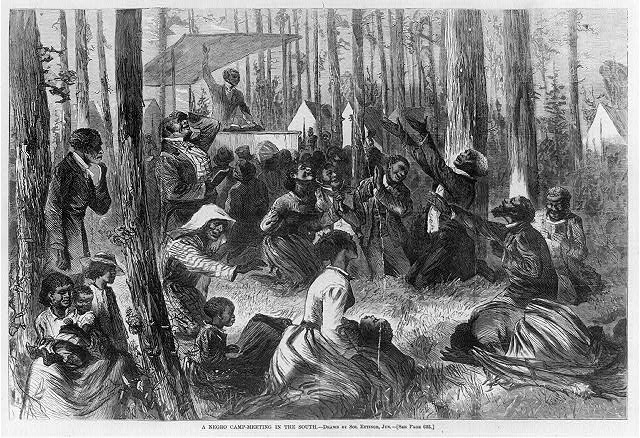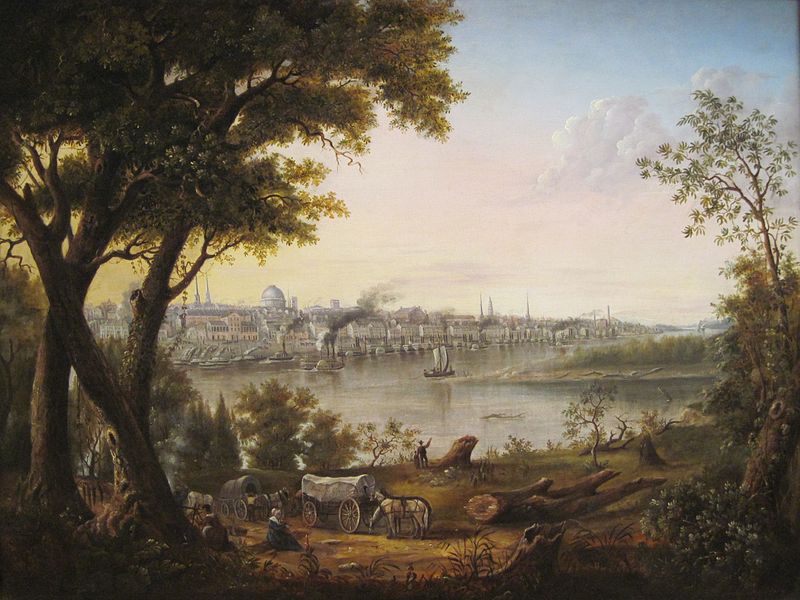What led to our knowledge, our tastes, our beliefs? However unexpected, the beliefs of our ancestors were as powerful and contextualized as our own. From these cultural roots, we must have helped each other survive. Friendships mitigate dehumanizing economic practices. Sharing resources allows us to thrive. Rights are hard won. The Compromise shows some of these cultural histories through shared religious experience, folk arts, urbanization, and the barter economy.
“Thier understanding of God was inseparable from their understanding of themselves, their shared vision of America, and their ability to break down social barriers.”
The Black Hearts of Men, 2001, by John Stauffer describes the lives of four abolitionists in a mixed-race friendship.

(after) Solomon Eytinge via WikiGallery.org [public domain]
Camp meetings, also known as revivals, met the needs of farmers and ranchers in rural areas. The meetings featured traveling preachers from several denominations. They engaged crowds with highly emotional experiences. The emphases were personal and experiential bonds to reinforce religious and social norms. Camp meeting participants camped out in large tents near a river for several days. They attracted thousands of men and women, free and enslaved people of all races and ethnic backgrounds.
The preacher lifted those words off the page and breathed life into them. He was more radiant than any earthly creature. At the same time, it pained me to feel my soul falling under his leather boots. Then the agile preacher caught my eye and held me tight. The white sheet was cast aside, and the long black coat was hung from his shoulders like a cape, leaving bare his manly chest. I was caught between curiosity and a strange morbid desire. He crossed the stage back and forth casting his arms toward the sky. With eyes glued on me, he said:
“Proof of this glorious glory is already here above us!”
“Glory, glory come for me,” shouted the crowd.
“The stars of heaven have fallen to the earth,” he said with his arms churning the air. “And behold! Rings grow around the sun to quench its light. Only the saved are not blinded by its rays. A great red comet lights the way of saints who are ready to ascend!”
The men and women around me fell on the ground asking forgiveness. I turned to look for Hester but she was gone.
The Compromise “The Camp Meeting 1844”
Vintage photographs and traditional songs influence me as I write The Compromise. Singing and playing music helped our ancestors adapted to hardship and loss. They funnction as touch stones to integrate new experience. In one scene, the siblings remember seeing a lynching in a cherry tree. They sing sad songs while they gather flowers for the wedding.
Early morning on the day of the wedding, Otis hitched a team to the buckboard to take several of us to Cherry Hill to gather flowers. Eliza and I sat with Otis. The younger ladies teased Johnny and laughed in the petal-laden breeze. It was early April, so Cherry Hill looked as it did on our ride out of Stoneville four years earlier. That day Eliza and I had seen a man hanging by a rope from a blossoming cherry tree.
“Black Cherry Hill,” said Otis. “Remember?”
“Mm-mm.” I said. “That lynching shook my soul, black fruit hanging in the tree of life.”
“Only the Almighty may uncouple life and death,” said Otis.
Eliza spoke part of a song. “And must my trembling spirit fly to see the flaming skies?”
Then we three sang the old song with more feeling than I had ever heard:
Am I born to die?
To lay my body down?
And must my trembling spirit fly
Into a world unknown?
The girls added their voices, bewitching a spring morning to gather blossoms:
A land of deepest shade
Unpierced by human thought
The dreary regions of the dead,
Where all things are forgot.
The Compromise, “The Wedding 1843”
The film Cold Mountain used Idumea in its score. Listen to the song, Am I Bord to Die?
Urbanization
Their generation and the nation were expanding into adulthood through rapid urbanization and westward expansion. But it expanded unevenly and often ruinously. Mariah is sometimes able to see the paradox of growth. Traveling for the first time on a steamship would be like a first flight on an airplane for us. New experience provides new metaphors to organize perception. I’ve described several of these turning points in Mariah’s life. In the description that follows, I’ve borrowed a transformed sense of time from Walt Whitman‘s Crossing Brooklyn Ferry (1855):
"And you that shall cross from shore to shore years hence are more to me, and more in my meditations, than you might suppose." -Whitman

The noise of the steam, the size of the turbines, and sloshing paddle wheel were like nothing I had ever known and not at all like being inside a wedding cake. This white monster churned the grey Missouri into white froth. I was a little Tom Thumb that did not fit this place. I watched the shore move back. Towns disappeared like toy cities, and the new horizon kept coming closer, faster, like something in a hurry to get here and then leave again. I imagined the shore lined with people and houses, clusters of them filling in the open spaces, and fast-moving carts crossing high above me. Time was nothing, and it was strange that I could stand here looking at the future.
The Compromise, ‘The River Belle 1845″
Barter Economy
People had to assess value and exchange goods before currency was commonly available and during a time of economic recession. There was a barter economy, and this led to exchanges of cultural information and friendship. People paid for goods and services with more goods and services, and this must have strengthened social bonds.
Mariah helped deliver a baby born from illegal miscegenation, when people of two different races have a child together. A creole family of mixed ethnicity came to adopt the child.

Creole families still live in rural Louisiana. Creole is a living language based on French. Zydeco is Creole music. 
Choctaw Belle (1850) painted by Phillip Romer via Wikimedia Commons
Fred said, “We’ve come to give a home to that baby if you’ll let us.” His wife got out of the cart with some help from Fred. She nodded to me and reached for the baby in my arms.
“My prayers are answered,” I said. “Can you care for him? He’s just starting out, only two months old.”
“I have four living girls,” she said. “We need a boy.” Then she spoke to Baby Joe in her native Creole: “Mo laimé twa.”
“Can you use a goat making plenty of good milk?” I asked.
“Will you take a lamb in trade?” asked the woman. “And a piglet?”
“That will do,” I said. I kissed Joe's head and handed him over. I felt more tears sparking as I turned to get the nanny goat tethered in the yard. What would I do with a lamb and a pig? But that baby needed fresh milk every hour and, most of all, a family where he was welcome.
The Compromise, “The Pull West 1845”